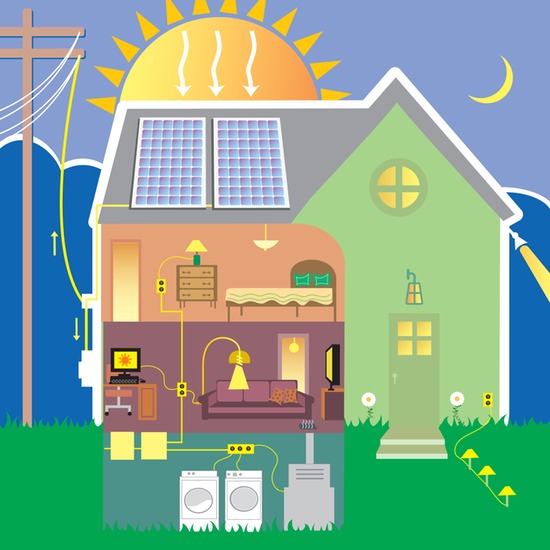With spring right around the corner—and one more hour of sunshine each day—why not use this time to spark a bright dinner table conversation with your kids about the sun?
First, ask your kids the questions below and see what imaginative responses you get. Then you can share the answers below with your kids; depending on the age of your children, you can respond with as little or as much detail as you like. Budding scientists and sun fans of all ages will love this conversation. Also included are a couple of fun-with-the-sun activities you can try together when you’re away from the table, to bring these concepts to life!
Why is the sun hot?
Because of a process called nuclear fusion. Little particles called protons, so tiny it would take a giant microscope to see them, buzz around until they collide, creating an atom. When these protons collide, they release energy and, with billions of them running into each other every second, that energy makes the sun very hot.
How hot is the sun?
The center of the sun is 27 million degrees Fahrenheit! To emphasize your point, compare that temperature to how hot it is outside today, how hot the oven was where your dinner cooked, or to the the boiling point of water [answer: 212 degrees F].
What is the sun made of?
The sun is mostly made of hydrogen, which is a very, very light gas. You’ve seen hydrogen before! In fact, it’s right in front of you on the dinner table, hanging out with its buddy, oxygen. That’s right, H20, or water, is two-thirds hydrogen. The other part of the sun is helium. Remember why the sun is hot? Because of all those protons colliding? When they collide, they create helium. Right now the sun is about 92% hydrogen and 8% helium.
Because it helps us see
Because it makes plants grow
Because we need it – the sun helps our skin make Vitamin D, which is needed for health and strong bones.
Follow-up project: Have your kids write down or list everything they had to eat today, and then ask them if these foods would have been available to them without sunlight. With no light to grow wheat, you’d have no bread, and with no sun to make the grass grow, there wouldn’t be any food for cows, so no milk, cheese or hamburgers.
Why do we need the sun’s heat?
Because it keeps us and everything on Earth from freezing
Because it powers the water cycle by evaporating water into clouds, which then turn into rain
Follow-up project: Show your kids how the water cycle works with a simple home experiment. Place a glass cup in a sturdy mixing bowl and have a parent pour boiling water in the bowl around the cup. Cover the bowl and cup with plastic wrap and place a small object like a stone or small bowl on the wrap directly over the cup. As the boiling water evaporates, it will condense on the plastic wrap and “rain” into the cup. You can show how this process also purifies the water by adding food coloring to the boiling water in the bowl. When it rains back into the cup, the water will be clear again.
What is sun energy, or solar energy?
The sun’s energy is a combination of both light and heat, creating what is called radiant energy. Radiant energy absorbed by the land and the oceans that helps to keep our planet warm.
Plants use the sun’s energy to create food through a process called photosynthesis
Humans use solar energy for lots of things: from keeping warm (for example, how sunny rooms are always warmer than dark ones) to collecting energy with the help of solar cells and solar panels , otherwise known as solar power.
How does solar power work? Solar panels are made of silicon, which is part of what makes sand. When sunlight hits the silicon, it causes tiny particles, called electrons, to dance around. Because of the nature of silicon, we can make the electrons dance right out of the solar panel and into electrical wires. Instant energy!
Follow-up project: This one should only be done by parents! On a sunny day, you can place a piece of paper (dark paper works best) on the ground and hold a full water bottle above it, directing the spot of sunlight that shines through it onto the paper. After a couple of seconds, the sunny spot will start to smolder. That’s solar energy at work!
Bonus Activity:
You can do this one before or after your dinner conversation. Download the song “Why Does the Sun Shine?” from the album Here Comes Science by They Might Be Giants, or watch the video here. Then let the wild rumpus begin! Once the kids finish dancing, you can point out the lyrics such as the first verse:
The sun is a mass of incandescent gas
A gigantic nuclear furnace
Where hydrogen is built into helium
At temperatures of millions of degrees.
Now have them brainstorm their own crazy comparisons for the sun and draw pictures to match.
Want to learn more about this hot topic? Check out some of the following excellent resources about the sun and solar energy created specifically for kids:
NASA’s Solar System Exploration Guide
 Chris Long has been a Home Depot store associate in the Chicago suburbs since 2000. Chris writes for the Home Depot blog and has been helping customers on DIY household topics ranging from solar power in the home to electrical, bath and painting projects.
Chris Long has been a Home Depot store associate in the Chicago suburbs since 2000. Chris writes for the Home Depot blog and has been helping customers on DIY household topics ranging from solar power in the home to electrical, bath and painting projects.
House image via



